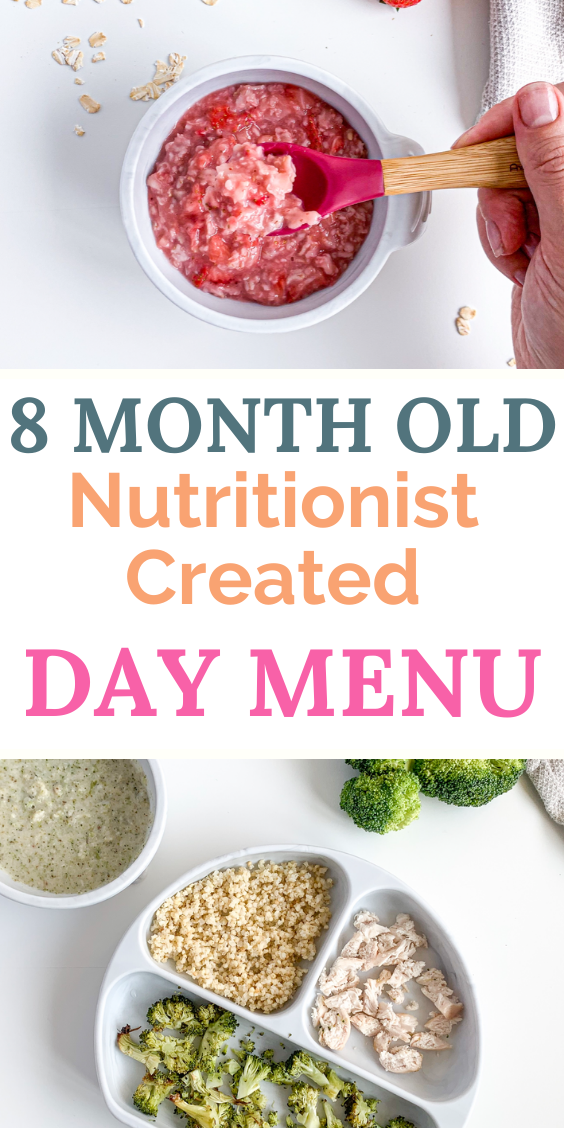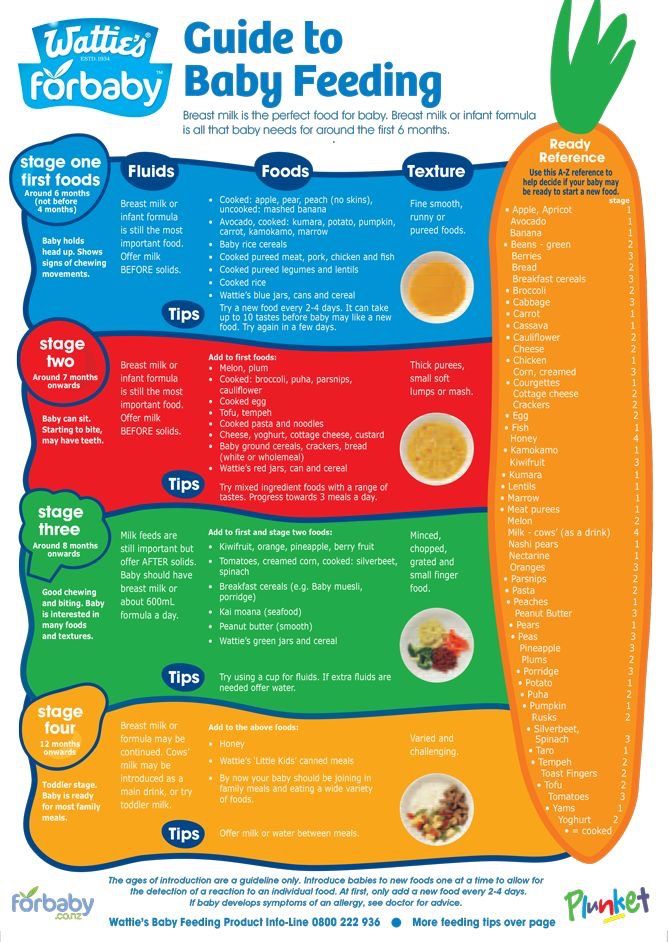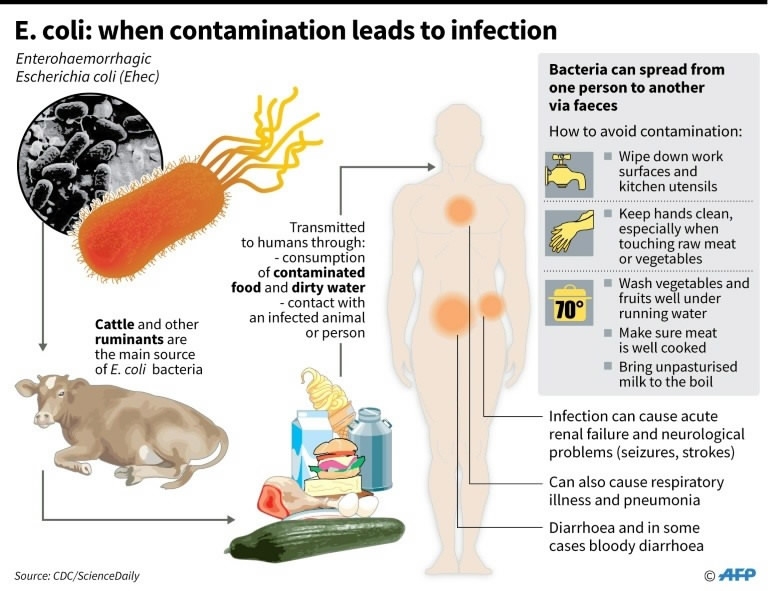How much baby food should i feed my 8 month old
Feeding your baby: 6–12 months
At 6 months of age, breastmilk continues to be a vital source of nutrition; but it’s not enough by itself. You need to now introduce your baby to solid food, in addition to breastmilk, to keep up with her growing needs.
Be sure you give your baby her first foods after she has breastfed, or between nursing sessions, so that your baby continues to breastfeed as much as possible.
When you start to feed your baby solid food, take extra care that she doesn’t become sick. As she crawls about and explores, germs can spread from her hands to her mouth. Protect your baby from getting sick by washing your and her hands with soap before preparing food and before every feeding.
Your baby's first foods
When your baby is 6 months old, she is just learning to chew. Her first foods need to be soft so they’re very easy to swallow, such as porridge or well mashed fruits and vegetables. Did you know that when porridge is too watery, it doesn't have as many nutrients? To make it more nutritious, cook it until it’s thick enough not to run off the spoon.
Feed your baby when you see her give signs that she's hungry – such as putting her hands to her mouth. After washing hands, start by giving your baby just two to three spoonfuls of soft food, twice a day. At this age, her stomach is small so she can only eat small amounts at each meal.
The taste of a new food may surprise your baby. Give her time to get used to these new foods and flavours. Be patient and don’t force your baby to eat. Watch for signs that she is full and stop feeding her then.
As your baby grows, her stomach also grows and she can eat more food with each meal.
Feeding your baby: 6–8 months old
From 6–8 months old, feed your baby half a cup of soft food two to three times a day. Your baby can eat anything except honey, which she shouldn't eat until she is a year old. You can start to add a healthy snack, like mashed fruit, between meals. As your baby gets increasing amounts of solid foods, she should continue to get the same amount of breastmilk.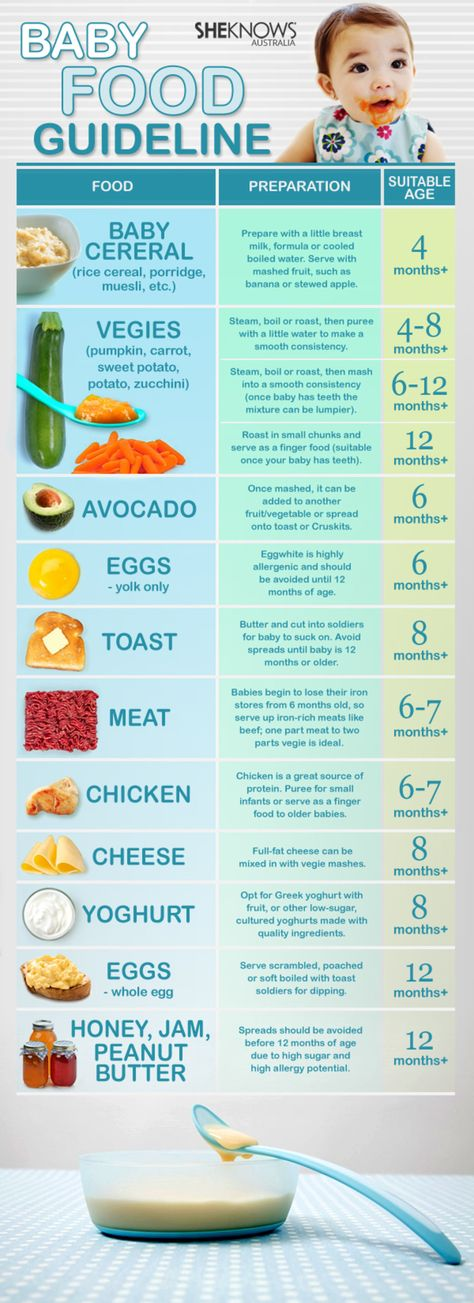
Feeding your baby: 9–11 months old
From 9–11 months old, your baby can take half a cup of food three to four times a day, plus a healthy snack. Now you can start to chop up soft food into small pieces instead of mashing it. Your baby may even start to eat food herself with her fingers. Continue to breastfeed whenever your baby is hungry.
Each meal needs to be both easy for your baby to eat and packed with nutrition. Make every bite count.
Foods need to be rich in energy and nutrients. In addition to grains and potatoes, be sure your baby has vegetables and fruits, legumes and seeds, a little energy-rich oil or fat, and – especially – animal foods (dairy, eggs, meat, fish and poultry) every day. Eating a variety of foods every day gives your baby the best chance of getting all the nutrients he needs.
If your baby refuses a new food or spits it out, don’t force it. Try again a few days later. You can also try mixing it with another food that your baby likes or squeezing a little breastmilk on top.
Feeding non-breastfed babies
If you're not breastfeeding your baby, she’ll need to eat more often. She'll also need to rely on other foods, including milk products, to get all the nutrition her body needs.
- Start to give your baby solid foods at 6 months of age, just as a breastfed baby would need. Begin with two to three spoonfuls of soft and mashed food four times a day, which will give her the nutrients she needs without breastmilk.
- From 6–8 months old, she’ll need half a cup of soft food four times a day, plus a healthy snack.
- From 9–11 months old, she’ll need half a cup of food four to five times a day, plus two healthy snacks.
How much should my baby eat? A guide to baby food portions
- Community
- Getting Pregnant
- Pregnancy
- Baby names
- Baby
- Toddler
- Child
- Health
- Family
- Courses
- Registry Builder
- Baby Products
Advertisement
Wondering how much to feed your baby? This can be hard to figure out, especially when you're starting solids and most of your baby's food ends up on your little one or the floor. It's also difficult to determine how much an 8-month-old (or older baby) should eat – babies this age are more interested in solid foods but still get most of their nutrition from breast milk or formula. This visual guide to baby food portions can help you figure out how much your baby should eat at every stage.
It's also difficult to determine how much an 8-month-old (or older baby) should eat – babies this age are more interested in solid foods but still get most of their nutrition from breast milk or formula. This visual guide to baby food portions can help you figure out how much your baby should eat at every stage.
Photo credit: Karla Martin for BabyCenter
How much should my baby eat?
Do you worry that your baby is eating too little or too much? Your baby will self-regulate her food intake based on what their body needs, so let their appetite be your guide.
It's helpful to have a reference point, however. Here are photos of how much solid food a baby typically eats in a day. You can also ask your baby's doctor for feeding advice.
This visual guide shows:
- Portions for infants who are new to solids (typically 4 to 6 months)
- Two sample meals for a younger baby (6 to 8 months)
- Three sample meals and two snacks for an older baby (8 to 12 months) from a menu developed by the American Academy of Pediatrics (AAP)
Your little one may eat less or more than what's shown here. Your job is to provide a variety of healthy foods at regular intervals without pressure, and their job is to decide what and how much to eat.
Your job is to provide a variety of healthy foods at regular intervals without pressure, and their job is to decide what and how much to eat.
Photo credit: iStock.com / UntitledImages
Watch for signs your baby is full
Lots of factors – including activity level, growth spurts or plateaus, illness, and teething – will affect your baby's appetite, which can vary daily.
End feeding when they signal that they're done. Signs of being full include:
- Turning their head away
- Refusing to open their mouth for another bite after they've swallowed (resist the urge to encourage your baby to have one last spoonful)
- Leaning back in their chair
- Playing with the spoon or food rather than eating
Photo credit: Karla Martin for BabyCenter
How much a 4- to 6-month-old should eat
When your baby is developmentally ready for solids, typically around 4 to 6 months, talk to their doctor about introducing solid foods. The first bites are mostly about them getting used to the idea of having something different in their mouth.
The first bites are mostly about them getting used to the idea of having something different in their mouth.
- Start with a very small amount, 1 to 2 teaspoons, of a single-ingredient puree.
- Gradually increase to 1 to 2 tablespoons of food once a day.
- Follow your baby's fullness cues.
Popular first foods include pureed mango, banana, chicken, turkey, beef, peas, sweet potatoes, and infant cereal. It's up to you what food to start with, but wait 3 to 5 days between introducing each new food to make sure your baby doesn't have an allergic reaction or food intolerance. (And remember, no cow's milk or honey until age 1.)
Photo credit: Karla Martin for BabyCenter
How much a 6- to 8-month-old should eat
As your little one gets more comfortable with solids, you can increase the frequency of meals and variety of food.
- Transition from one to two meals a day, typically by 8 months.
- Over time, add a second food to each meal.
 The photo above is an example of a meal with two foods.
The photo above is an example of a meal with two foods. - Once you've worked up to two meals with two foods each, aim for a balance of proteins, vegetables, fruits, and grains in their daily diet.
- Whenever you introduce a new food, start with a very small amount, a teaspoon or two, to allow your baby to get used to its flavor and texture.
- Start with a soupy consistency. Gradually add more texture as their eating skills improve.
Expect their intake of breast milk or formula to go down. They'll start drinking less of it as they eat more solid foods. Provide healthy options at mealtimes, and let them choose how much to eat.
Note: The jars in all photos are standard 4-ounce baby food jars.
Photo credit: Karla Martin for BabyCenter
Breakfast for a younger baby (6 to 8 months)
Cereal and fruit make an easy combination for a morning meal.
Grain: Iron-fortified, whole-grain infant cereal is a popular first grain. At 6 months, a typical daily portion of infant cereal mixed with breast milk or formula might be 2 to 3 tablespoons, increasing to 4 to 8 tablespoons (1/4 to 1/2 cup) by 8 months. (It's best to avoid rice cereal, though.)
At 6 months, a typical daily portion of infant cereal mixed with breast milk or formula might be 2 to 3 tablespoons, increasing to 4 to 8 tablespoons (1/4 to 1/2 cup) by 8 months. (It's best to avoid rice cereal, though.)
Fruit: Babies love the natural sweetness of fruits like pears, apples, berries, prunes, and stone fruits. Between 6 and 8 months, a baby will typically transition from about 2 to 3 tablespoons of fruit puree a day to 4 to 8 tablespoons (1/4 to 1/2 cup) of mashed or minced fruit.
Photo credit: Karla Martin for BabyCenter
Dinner for a younger baby (6 to 8 months)
If you serve a grain and fruit in the morning, consider offering a protein-rich food and vegetable later in the day. Your child may eat more or less than the amounts shown.
Protein: A baby might transition from eating 1 to 2 tablespoons of meat puree at 6 months to 2 to 4 tablespoons at 8 months, for example. Other good protein sources include cheese, unsweetened plain whole-milk yogurt, tofu, beans, and lentils.
Vegetables: Between 6 and 8 months, a baby will typically transition from about 2 to 3 tablespoons of vegetable puree a day to 4 to 8 tablespoons (1/4 to 1/2 cup). Try classic favorites like carrots, spinach, or butternut squash, as well as less traditional first foods such as parsnips, beets, or asparagus.
As your child's eating skills improve, gradually add more texture by dicing or mincing foods.
Photo credit: Karla Martin for BabyCenter
How much an 8- to 12-month-old should eat
By 8 months or so, your baby is likely getting the hang of eating and needs to eat more calories to support their growing body. But since their little belly can't hold a lot of food, they'll need to eat more often. Every baby is different, but this may be a good time to try offering a third solid food meal.
During this period:
- Continue to give your baby breast milk or formula.
- Add morning and afternoon snacks. (Some babies this age are happy with breast milk or formula as their snack, while others gravitate toward solid foods.
 ) Once you've added a third meal and snacks, your baby will be eating or drinking something about every two to three hours.
) Once you've added a third meal and snacks, your baby will be eating or drinking something about every two to three hours.
- Continue to aim for a mix of proteins, vegetables, fruits, and grains.
- Introduce coarser and chunkier textures, for example, by dicing or mincing food instead of pureeing it, and graduate to soft finger foods as your baby's eating skills improve.
- Avoid foods with added sugars. Check the Nutrition Facts label on packaged foods, and try to steer clear of foods that list 1 gram or more of "Added Sugars."
- Provide healthy options, and let your baby choose how much to eat.
To visualize daily portions for an 8- to 12-month-old, check out the following photos of a typical day's menu for a baby this age, developed by the AAP.
Your child may eat more or less than these amounts. If you're concerned about how much your baby is eating, talk to their doctor for advice.
Photo credit: Karla Martin for BabyCenter
Breakfast for an older baby (8 to 12 months)
The AAP sample menu for a baby 8 to 12 months features a breakfast consisting of:
- 4 to 8 tablespoons (1/4 to 1/2 cup) whole-grain infant cereal mixed with formula or breast milk
- 4 to 8 tablespoons (1/4 to 1/2 cup) diced fruit
Note: This is an example. Your baby may eat different foods and amounts.
Your baby may eat different foods and amounts.
Photo credit: Karla Martin for BabyCenter
Morning snack for an older baby (8 to 12 months)
The AAP sample menu for a baby 8 to 12 months features a morning snack consisting of:
- 4 tablespoons (1/4 cup) diced cheese or cooked vegetables
Note: This is an example of a morning snack, which babies typically add sometime between 8 and 12 months. Your baby may eat different foods and amounts.
Photo credit: Karla Martin for BabyCenter
Lunch for an older baby (8 to 12 months)
The AAP sample menu for a baby 8 to 12 months features a lunch consisting of:
- 4 to 8 tablespoons (1/4 to 1/2 cup) unsweetened plain whole-milk yogurt or cottage cheese, or minced meat
- 4 to 8 tablespoons (1/4 to 1/2 cup) diced or mashed yellow or orange vegetable
Note: This is an example. Your baby may eat different foods and amounts.
Photo credit: Karla Martin for BabyCenter
Afternoon snack for an older baby (8 to 12 months)
The AAP sample menu for a baby 8 to 12 months features an afternoon snack consisting of:
- 4 tablespoons (1/4 cup) diced fruit or unsweetened plain whole-milk yogurt
- 1 whole-grain teething biscuit or cracker
Note: This is an example of an afternoon snack, which babies typically add sometime between 8 and 12 months. Your baby may eat different foods and amounts.
Your baby may eat different foods and amounts.
Photo credit: Karla Martin for BabyCenter
Dinner for older baby (8 to 12 months)
The AAP sample menu for a baby 8 to 12 months features a dinner consisting of:
- 4 tablespoons (1/4 cup) minced or ground poultry or meat, or diced tofu
- 4 to 8 tablespoons (1/4 to 1/2) cup diced, cooked green vegetable
- 4 tablespoons (1/4 cup) noodles, pasta, rice, or potato
- 4 tablespoons (1/4 cup) diced fruit
Note: This is an example. Your baby may eat different foods and amounts.
Photo credit: Karla Martin for BabyCenter
How much should my baby drink once they start eating solids?
Breast milk or formula will fully meet your child's hydration needs until they're about 6 months old. They may start drinking less as solid foods become a bigger part of their diet. Here are typical daily amounts by age – your baby's intake may be different, however.
6 to 8 months: 24 to 32 ounces of formula, or continued breastfeeding on demand
8 to 12 months: 24 ounces of formula, or continued breastfeeding on demand
Water: You can offer your baby water once they start eating solids, but let them self-regulate how much they drink. The Centers for Disease Control and Prevention (CDC) recommends giving babies who are 6 to 12 months old 4 to 6 ounces of water a day, but what your baby decides to drink may vary. They may drink more on a hot day, for example.
Avoid juice: Juice isn't recommended for babies younger than 12 months.
Photo credit: iStock.com / SDI Productions
Your baby has the final say
Keep in mind that these portions are an estimate. The truth is, every baby is different, and there's no set amount of food that's appropriate for every baby at every stage.
If you're worried about whether your baby is eating enough – or too much – the best advice is to look for and respond to signs that your baby is full.
Your baby's doctor will chart their weight gain at regular intervals. If the doctor sees a consistent growth curve and doesn't have other concerns, your baby is most likely eating the right amount of food.
Hungry for more?
Age-by-age guide to feeding your baby
The 10 best foods for babies
The worst foods for babies
Using spices and seasoning in baby food
Elizabeth Dougherty
Elizabeth Dougherty is a veteran parenting writer and editor who's been contributing to BabyCenter since 2015. She's an intrepid traveler, devoted yogi, and longtime resident of Silicon Valley, where she lives with her husband and son.
Advertisement | page continues below
Ration: making a menu for a child at 8 months
6-12 months
Article
5/5 4 reviews
The first year of a baby's life is full of discoveries. He almost daily learns something new about the world, in particular, gets acquainted with new products. At 6 months, the baby masters gruel, vegetable and fruit purees. The menu of a child at 8 months becomes more diverse. Sour-milk products, meat, lean fish and egg yolks appear in the diet. How to introduce new food into the baby's complementary foods? And how to make a tasty and healthy menu? nine0003
He almost daily learns something new about the world, in particular, gets acquainted with new products. At 6 months, the baby masters gruel, vegetable and fruit purees. The menu of a child at 8 months becomes more diverse. Sour-milk products, meat, lean fish and egg yolks appear in the diet. How to introduce new food into the baby's complementary foods? And how to make a tasty and healthy menu? nine0003
7 min. for reading Feb. 17, 2022
What can I give my baby at 8 months? What foods to add to the diet to ensure a balanced diet? Here is a rough list that you can take into account.
1. Egg yolks.
The polyunsaturated fatty acids and healthy cholesterol they contain are essential for the development of the nervous system. The yolk can be given to children from 7–8 months of age, starting with half a chicken or one quail. By this time, enzymes appear in the body to break down this product. nine0017 Important!
nine0017 Important!
Some people think that quail yolks are better digested and can therefore be given to allergic babies. But quail yolk can also cause a negative reaction. Therefore, eggs must be introduced into the diet with caution, starting with 1 teaspoon and monitoring the reaction.
2. Porridge.
At the age of 8 months, a child can already eat all kinds of cereals: buckwheat, rice, oatmeal, corn and wheat. By consistency, they should be quite liquid and homogeneous. To cook baby porridge correctly, see the instructions on the product packaging and follow all the recommendations. nine0003
Learn more: Gerber® Cereals
3. Meat.
Introduce solid foods gradually, giving your baby dietary varieties: chicken, veal, turkey and rabbit. The meat is rich in proteins, which are necessary for growth and development, and iron, and is also very useful for the circulatory system. The norm of meat is about 50-70 g per day.
Learn more: Gerber® Meat Purees
4. Lean white fish.
If the baby does not have a tendency to allergic reactions and your pediatrician sees no contraindications, let him try the fish. Due to the smaller amount of connective tissue, fish is an excellent source of easily digestible protein. It contains many minerals, amino acids, arachidonic acid, fluorine and iodine. The latter are minerals needed to strengthen bones and improve thyroid hormone production. In addition, there are a lot of omega-3 polyunsaturated fatty acids in fish, which are needed for the cells of the brain, vision, cardiovascular system and immunity of the child to develop normally. Start introducing fish into the child's menu at 8 months with a teaspoon and carefully monitor that there are no adverse events. If all is well, then give it no more than twice a week. nine0003
5. Fruit and vegetable purees.
Your little one has already become familiar with these products, but you can diversify the taste a bit by combining vegetables with meat or different types of fruits.
Learn more: Gerber® Vegetable and Meat Puree
6. Dairy products.
Kefir and cottage cheese are good for the intestines, but can cause bloating, colic or allergies. Therefore, first consult with your doctor and introduce dairy products very carefully. nine0003
See also: Why is cow's milk not good for babies?
7. Vegetable decoctions and light soups.
Start with vegetable broths made from potatoes and carrots, lightly seasoned with onions. For the first time, give 20-30 grams, and if the baby perceives the dish well, gradually increase the amount of soup and the variety of its ingredients.
8. Flour.
You can dilute the menu with baby biscuits, crackers and bread. But enter them carefully. In flour products there is a special protein of plant origin - gluten, to which the baby's fragile body can react with allergies and diarrhea. nine0003
Diet: when and how much to eat at 8 months
- If the baby is breastfed, feed him about once every 3-4 hours.

- If the baby is fed expressed breast milk, give him approximately 700 grams per day. With 5-6 meals a day, this is about 120 to 200 grams of milk per meal.
- Formula-fed (IV) babies are given 170 to 230 grams of formula 4-6 times a day. To find out exactly how much mixture you need, be guided by the instructions on the package, the recommendations of the pediatrician. nine0086
- Complementary foods are best included in the menu of a child at 8 months three times a day: it can be one teaspoon per sample or 50-180 grams of already familiar food.
Important!
The calculation of servings and the number of feedings depends on the individual characteristics of the development and needs of the child. Therefore, first of all, be guided by the recommendations of your pediatrician and the needs of the baby.
We form the basis of the diet for every day
At 8 months old, a baby needs a variety of foods with enough calories to ensure that the actively growing body receives sufficient nutrients. Divide the daily food intake, which is approximately 1000–1200 ml, into 5–6 doses at intervals of 3.5–4 hours: early breakfast, breakfast, lunch, dinner and feeding before bedtime. If the baby is not full on complementary foods, supplement with breast milk or formula if the baby is formula-fed.
Divide the daily food intake, which is approximately 1000–1200 ml, into 5–6 doses at intervals of 3.5–4 hours: early breakfast, breakfast, lunch, dinner and feeding before bedtime. If the baby is not full on complementary foods, supplement with breast milk or formula if the baby is formula-fed.
Tip!
Do not salt or sweeten food. Introduce the baby to sugar and salt not earlier than 12 months, but better later.
The list of allowed foods at 8 months of age is quite extensive, which gives you room for culinary experiments. Use this table to create a menu for the week, changing types of cereals, alternating purees and juices from different vegetables and fruits, adding new foods or additional ingredients to dishes already familiar to your baby. For example, if the crumbs are already fed up with some kind of porridge or mashed potatoes, improve the recipe a little - add a spoonful of vegetable or butter, or pieces of fruit.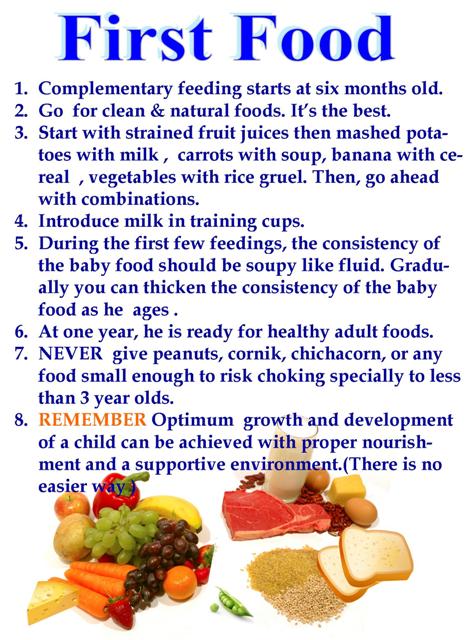 And the child will eat again with pleasure. nine0003
And the child will eat again with pleasure. nine0003
Read also: Breastfeeding: first steps after childbirth
Important!
If the child is allergic, add something new to the diet with extra care. Especially food rich in animal proteins - cottage cheese, kefir, yolks, milk porridge, fish. Before offering them to your baby, consult a pediatrician.
Sample menu for a child at 8 months per day: table
| Feeding time | Products | Serving Size |
|---|---|---|
| I feeding 6 hours | Breast milk or infant formula | 200 ml |
| II feeding 10 hours | Gerber® Milk Oatmeal with Banana and Mango | 170 g |
| Butter | about ½ tsp | |
| Boiled egg yolk | ½ pcs. | |
| Supplementing with breast milk or infant formula | 50 ml | |
| III feeding 10 hours | Gerber® Meat and Vegetable Puree "Tender Vegetables with Veal" | 170 g |
| Vegetable oil | about ½ tsp. | |
| Gerber® Clarified Apple-Pear Juice | ½ pcs. | |
| Supplementing with breast milk or infant formula | 50 ml | |
| IV feeding 18 hours | Gerber® Apple & Wild Berries Fruit Puree | 70 g |
| Baby biscuits | 1-2 pcs. | |
| Kefir | 40 ml | |
| Supplementing with breast milk or infant formula | 100 ml | |
| V feeding 22 hours | Breast milk or infant formula | 200 ml |
Sample diet for an 8 month old baby with cow's milk protein intolerance: table
| Feeding time | Products | Serving Size |
|---|---|---|
| I feeding 6 hours | Breast milk or formula for infants with cow's milk protein intolerance | 200 ml |
| II feeding 10 hours | nine0151 Dairy-free Gerber® oatmeal with wheat130 g | |
| Vegetable oil | about 1 tsp. | |
| Gerber® Apple & Peach Fruit Puree | 70 g | |
| Gerber® Clarified Apple Juice | 30 ml | |
| III feeding 10 hours | Gerber® Cauliflower & Potato Puree | 170 g |
| Vegetable oil | about 1 tsp. | |
| Gerber® Gentle Rabbit Meat Puree | 50 g | |
| Gerber® Broccoli Vegetable Puree | 70 g | |
| IV feeding 18 hours | Vegetable oil | about 1 tsp. |
| Gerber® Tender Turkey Meat Puree | 30 g | |
| Supplementation with breast milk or formula for infants with cow's milk protein intolerance | 100 ml | |
| Breast milk or formula for infants with cow's milk protein intolerance | 200 ml |
Important!
To create a menu for a child, calculate the size of portions and the number of feedings, first of all, be guided by the recommendations of your pediatrician, the individual needs and characteristics of your baby's body.
FAQ:
1. How much should a baby eat at 8 months?
An 8-month-old baby needs a portion of food per day, which is equal to about ⅛ of body weight. This is 1000-1300 ml of food, excluding water, juices, children's tea. Divide this amount by about 5 feedings and you will get a single serving of 200-210 ml.
2. When can cow's and goat's milk be added to complementary foods?
Whole cow's and goat's milk should not be given to children until at least 9 years of age according to WHO recommendations.months, and possibly up to 12 months. In order not to deprive the baby of the benefits of dairy products, replace with milk-baby kefir, yogurt, cottage cheese. But before introducing dairy into the menu, consult with your pediatrician.
3. If the baby has allergies, what should I do?
Atopic dermatitis, redness, itching are all signs of intolerance to a substance or food. If, after introducing a new food, you notice any of these symptoms, you need to eliminate the allergen from the diet. If you experience severe symptoms: swelling, vomiting, diarrhea, difficulty breathing, consult a doctor immediately. The pediatrician will select the therapy for the baby: it can be a special diet or medication. nine0003
If you experience severe symptoms: swelling, vomiting, diarrhea, difficulty breathing, consult a doctor immediately. The pediatrician will select the therapy for the baby: it can be a special diet or medication. nine0003
Articles on the topic:
Baby refuses new foods
Eat right and without mistakes
Products containing iron
Last reviews
Average customer rating
4 customer ratings
Snapshot of community ratings
- five 4
- 4 0
- 3 0
- 2 0 nine0086
- one 0
the optimal menu for an eight-month-old baby
01/29/2019
41
When my child was 8 months old, I began to be advised to make adult food the basis of his diet and reduce the number of feedings. But I decided to study the issue and share with you. Let's find out how the eating behavior of an 8-month-old baby changes.
Let's find out how the eating behavior of an 8-month-old baby changes.
Important foods for an 8 month old baby
At this age, the main food of the baby is still breast milk or formula. Their volume will reach up to 700-900 milliliters per day. But adult food is still in second place, although the composition of complementary foods is already expanding. The child becomes more and more familiar with new tastes, he develops food interest.
Let's see what can be added to the diet:
Cereals:
In addition to buckwheat, rice and corn, oatmeal is added. Also, a child can already try pasta and vermicelli for soups. But it is better to introduce bread not earlier than a year. nine0003
Vegetables:
Broccoli and cauliflower, spinach, green beans are added in addition.
Fruit
The child can already taste bananas, prunes, plums, peaches, nectarines and apricots.
Meat
Add turkey, rabbit, chicken and veal to your menu. But soups with meat broth should be avoided for the time being.
Eggs
Since eggs can cause allergies, the hard-boiled yolk is given a taste first. A whole egg can be given after a year. nine0003
Fish
This is a new food item. For an eight-month-old baby to get acquainted with fish, cod is suitable.
Oil
Choose butter, olive and sunflower oils.
Fermented milk products
Many mothers introduce them as early as possible to provide the baby with calcium. You can give pureed cottage cheese and yogurt.
Biscuits
Baby biscuits should be added in small portions even if the child already chews well. nine0003
Drinks
In addition to breast milk or formula, offer your baby other liquids such as water, juice or compote.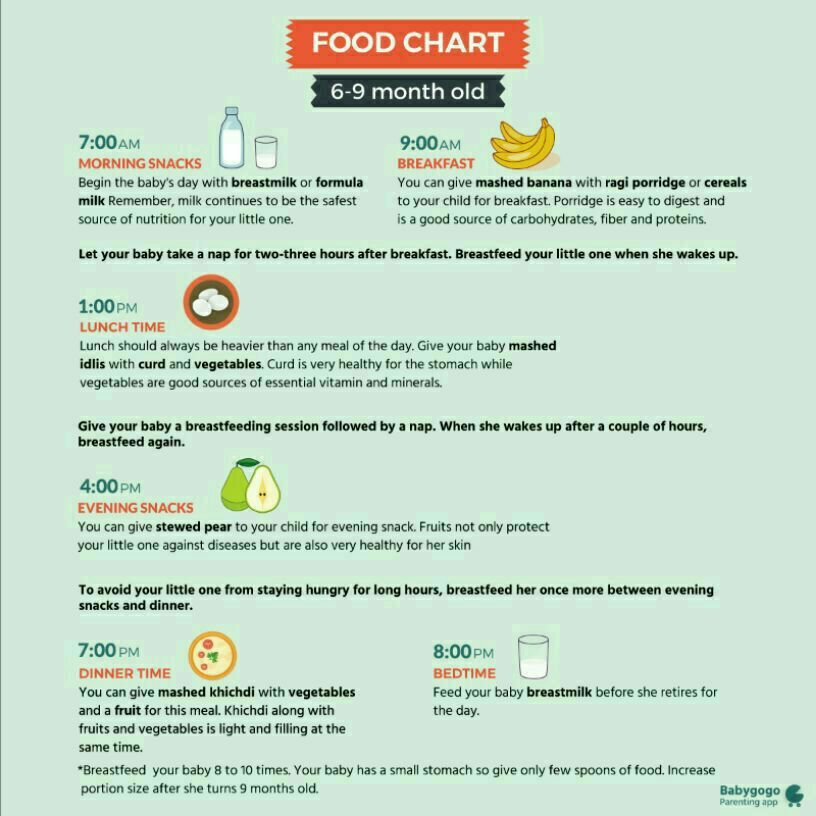
How to cook and serve food
Cooked fruits and vegetables can be given to your child. We cook food mostly still in a soft and puree form. It is better to make porridge boiled to feed the baby.
At this age, the child begins to take food by himself and is already better able to chew. To practice these skills, offer food in the form of pieces so that he can take them by hand. For example, bananas, pasta, meat and vegetables. Never leave your baby unattended while feeding. Do not give grapes, raw carrots, raisins, as they are easy to choke on. nine0003
Offer new food in the morning. And in the evening you can have the dishes familiar to the child.
A table with an example of what the daily menu of an 8-month-old baby might look like (suitable for both breastfeeding and IV):
Remember that this is just one example of nutrition at this age.
When introducing new products and monitoring the nutrition of an eight-month-old baby, be guided by the baby and his taste preferences.
